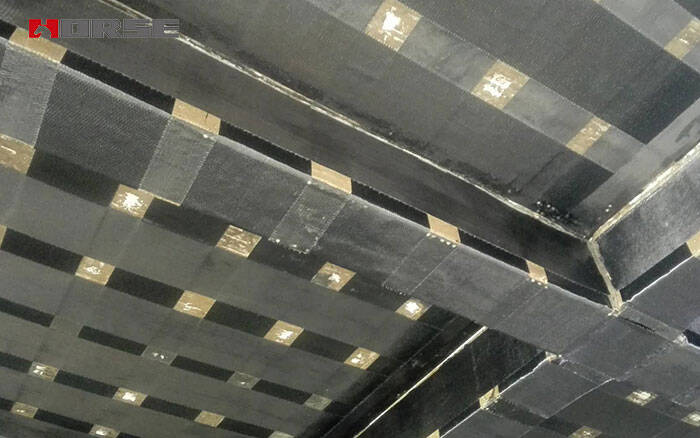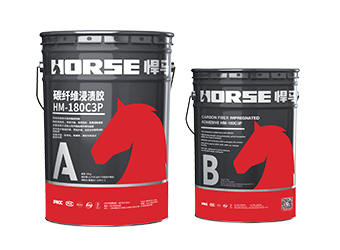Solutions
Horse Construction offers full range of structural strengthening materials with technical supports, documentation supports, products supports, project supports.
The reinforcing mechanism of CFRP used in tension reinforcement is similar to that of bonded steel plate. That is to say, CFRP is used to reinforce tension steel bars, so as to improve the bearing capacity of members.

The reinforcing mechanism of CFRP used in tension reinforcement is similar to that of bonded steel plate. That is to say, CFRP is used to reinforce tension steel bars, so as to improve the bearing capacity of members. The tensile test of CFRP bonded on the bottom of the plate proves that the ultimate bearing capacity of the strengthened plate is obviously improved, and CFRP plays a greater role in the later stage of loading, especially after the steel bar yields. When the reinforced concrete slab is subjected to tension, the fish oil of the member will be damaged by the tension and bending of the longitudinal expansion force with very small limit value. If transverse constraints can be created at the bottom of the member to organize the longitudinal expansion of the tension member, so as to improve the tensile capacity and deformation capacity of the member.
Carbon fiber reinforced concrete (CFS) is used to reinforce reinforced concrete slabs, which is a constraint between the concrete slab and the CFS strength zone. (the interaction force between them becomes the interface constraint stress). Due to the severe damage of the longitudinal interface constraint, the core concrete in the plastic zone is in the three direction stress state. Compared with unidirectional loading, the ultimate tensile strain and load-bearing capacity of concrete will be increased, and reinforced concrete slabs after reinforcement have larger ductile deformation and energy dissipation capacity.
Because the constraint of CFS on reinforced concrete slabs is interface constraint, only when the concrete expands outward and transversely (plastic deformation) can CFS produce constraint stress on concrete. Therefore, the CFS enclosed beam shows two stages of loading process. In the first stage, the longitudinal tensile stress of concrete is small, the transverse deformation is small, and the CFS force is small. In the second stage, with the increase of load, the deformation of slab concrete increases, the transverse stress of CFS increases significantly, and the transverse restraint force increases rapidly until the CFS reaches the ultimate tensile strain and breaks.
Carbon fiber reinforced materials for building structural reinforcement have excellent mechanical properties, such as excellent corrosion resistance, simple construction, good permeability and uniformity, and their tensile strength is about 10 times that of ordinary steel. However, after the carbon fiber material is woven into carbon fiber cloth, the carbon fibers are difficult to work together. When the load is lower, some of the carbon fibers with higher stress level first reach their tensile strength and withdraw from working state. In this way, the carbon fibers gradually break down until the whole body is broken, thereby improving the bearing capacity of the components. After using the binder, the carbon fibers can work well together and greatly improve the tensile strength of the carbon fibers. Therefore, CFRP reinforcement must first enable the CFRP in the CFRP to work together, so the binder plays a key role in the reinforcement of CFRP. It not only ensures that all carbon fibre filaments work together, but also ensures that carbon fibre cloth and structure work together, so as to achieve the purpose of strengthening and repairing.
It is noteworthy that the number of concrete bonding layers needs to be determined by calculation when using carbon fibers for reinforcement. Considering the working coefficients of each layer, the fatigue resistance and the avoidance of brittle failure, half of them should not exceed five layers. In addition, from the point of view of mechanical performance, the single layer is better than the multi-layer, and the narrow width is better than the wide width. If necessary, the length of overlap should not be less than 100 mm. Besides the calculation requirement, the necessary structural measures should be taken to ensure the reliable anchorage at the end of carbon fibers.
You can find anything here you are in need of, have a trust trying on these products, you will find the big difference after that.

High strength, unidirectional carbon fiber wrap pre-saturated to form a carbon fiber reinforced polymer (CFRP) wrap used to strengthen structural concrete elements.

Good impregnation carbon fiber adhesive for applying carbon fiber reinforced polymer(CFRP) wrap for structural strengthening

High strength carbon fiber reinforced polymer (CFRP) strip / laminate / plate for structural strengthening and concrete repair